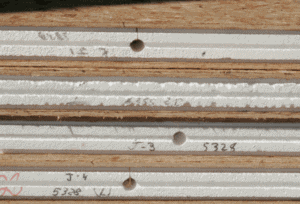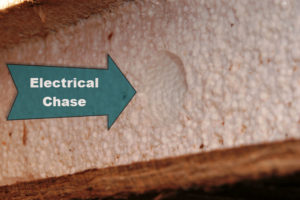When you’re building a conventionally framed home, you don’t think much about pre-planning the electrical system. Sure, you may talk about having enough outlets in the kitchen, or that your hobby room has ample power for your various lights and equipment. However, it’s generally a non-issue when building a standard 2×4 house. Running wires in SIPs panels takes a bit more pre-planning.

How Do I Run Wire Through A SIPs Wall?
Since SIPs are solid insulating foam surrounded by rigid panels, it’s not quite as easy as grabbing a Sawzall and cutting a hole in drywall. You need to note on your electrical blueprint the location of all outlets, lighting receptacles and switches, wiring junctions, telephone outlet, cable television outlets and computer wiring circuits.
Your SIPs manufacturer will use this information to place conduit runs and electrical box locations in your home’s wall panels. Horizontal chases are generally placed at industry standard switch and outlet heights.
Depending on the manufacturer’s designs, vertical chases may be cored through the body of the panels or they may be run near the edge of the panel. These horizontal and vertical conduit runs allow the electrician to snake wires along the perimeter of the structure and run wiring from one floor to the next.

Since the panels are all prefabricated before arriving at your work site, it’s a good idea to keep things simple on the exterior walls. Limit your wiring in the SIPs walls to switches, lighting and receptacles and plan for the minimum code requirements.
Try to place your feeds to other levels of the house through conventional interior walls and floors. You may want to consider a conventionally framed wall where the electrical service panel is located. There’s a lot of wires there, and it may be a more practical solution for that particular area. Talk with your contractor about which method is most effective for this area of your home.
How Do The Channels Affect The Insulating Factor Of SIPs?
The insulating nature of SIPs makes them a very attractive building alternative. However, when you compromise the solid core, you’re subtracting from the insulating power of the material. Part of the job is making sure that once the wiring is complete, the raceways and voids are filled with foam. This restores the R-factor and ensures you have a properly insulated home.
This segment in building your home is sort of invisible. It’s an area that can be done poorly, or not at all, and no one is the wiser at first glance. Insulating these raceways is time consuming and an added labor expense for the installer. You and your contractor should be watchful that all cavities are properly injected with foam after the wires have been pulled and the electrical work is completed.
Running Wires in SIPs – Minimize Electrical Needs To Exterior Walls
One way to reduce your expense in having a lot of custom made SIPs panels fabricated with electrical raceways is to have the bulk of your wiring running through the interior walls of your home. Although your timber frame home has specially constructed exterior walls, your interior partitions are standard 2×4 construction. By eliminating all but the basic electrical requirements to your SIPs wall, you can save time, labor and money.
Think about your future needs while you’re planning your electrical plan. It’s far easier and more economical to add access for future needs now than it is to add them later. Don’t shortchange your future goals by scrimping on your current budget. Plan well and plan wisely.
I’m glad to know that running wires or cables through SIPs won’t necessarily damage their R factor. I don’t really want to have cables run on the outside of my walls. I will just make sure more insulating foam is injected after the cables are run through the walls. Thanks!
When injecting additional insulating foam,after the cables are run, make sure it’s rated for electrical wires. Some foam will dissolved the wire plastic casing, that’s a mess..
That would be a mess. Thanks for the note Roger!